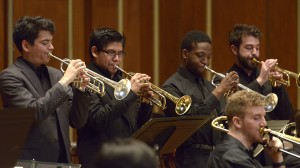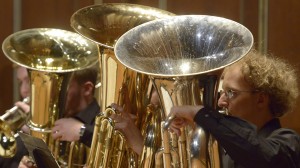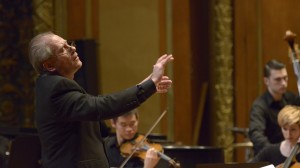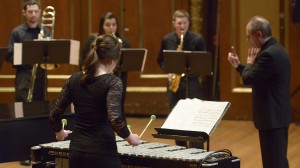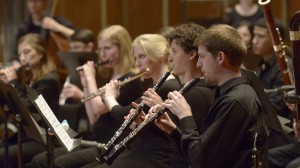Concert Review: NEC Winds Play Mingus, Schuller, Babbitt (and More)
By Steve Elman
The five compositions and one de facto suite played at the NEC Winds and Winds Ensemble performance spoke with six different voices and carried six different messages.
I pity the curators at the New England Conservatory who tried to find a title that would encompass the huge range of music performed at Jordan Hall on March 6. The event probably began as a concert to show off the skills of the Conservatory’s Symphonic Winds and Wind Ensemble in connection with a conference of the Eastern Division of the College Band Directors’ National Association. It also was supposed to provide a second hearing for works performed in a February concert called “Third Stream Headwaters” that had to be cancelled because of snow.
There were a few threads of continuity throughout the two and a half hours — the music was mostly for winds, mostly jazz-influenced in one way or another, and consistently virtuosic. Beyond those threads, the fabric frayed. The five compositions and one de facto suite spoke with six different voices and carried six different messages. I decided to listen to them as six independent mini-concerts:
Resurrecting Early Mingus
One of the most important events of the evening was the world premiere of Ken Schaphorst’s reconstruction of Charles Mingus’s “Half-Mast Inhibition.” According to Mingus, he wrote it in his late teens, and it was his first attempt to work in an extended form. He came back to it in 1960, as a mature musician in his 30s, carrying the yellowed and disintegrating manuscript paper into recording sessions for his LP entitled Pre-Bird. There were compromises and revisions incorporated into that recording, and then Mingus set it aside. Before March 6, it had never been performed in a concert hall.
Schaphorst, who chairs Jazz Studies and Improvisation at NEC, set out to create a performing score so that “Half-Mast Inhibition” could finally be played before an audience and studied. To do that, he had to get permission from the Mingus estate, find the original manuscript among Mingus’s papers at the Library of Congress, transcribe the changes undertaken for the recorded version, and produce a complete score that would respect Mingus’s original conception.
His efforts were worth it. We can now hear “Half-Mast Inhibition” as the first expression of the “composer” Mingus as opposed to the “bandleader” Mingus, where his love for Ellington’s music is enriched with dense, contemporary harmony in service to a dark vision of the creative individual struggling against misunderstanding and mortality. The seeds planted in “Half-Mast Inhibition” bear fruit later, in (for example) “Revelations,” “Far Wells, Mill Valley,” “The Black Saint and the Sinner Lady,” “Don’t Be Afraid, the Clown’s Afraid Too,” and the gigantic suite “Epitaph,” which was completed and orchestrated by Gunther Schuller.
“Half-Mast Inhibition” is episodic and fragmented, but this is hardly a new problem. Ellington faced the same issue when he tried to extend his ideas outside of a three-minute frame, and many minor classical composers have confronted it as well. Neither Mingus nor Ellington had the advantage of early formal training in composition that would have schooled him in the classical techniques of development and given him tools to use or discard as his inspiration permitted. So there’s a sense of reaching without quite grasping in this piece—moments of great beauty and moments of great power, without the technical ability to bring them all together into a unified whole. Still, this is amazingly mature music, and Schaphorst’s work was rewarded with a vigorous and enthusiastic performance that negotiated all the changes nimbly, thanks to Charles Peltz’s extraordinary conducting (but more about Peltz later), and a prominent solo part for the cellist of the Borromeo Quartet, Yessun Kim.
21st-Century Schuller
Newly-minted Gunther Schuller proved just as important as long-lost Charles Mingus in this concert. Although much of Schuller’s music and scholarship reflects his love for jazz, he has created a significant body of pieces that are explicitly Third Stream, to use the term he coined. This sub-group of compositions is sui generis, even within the idea of hybrid music, and perhaps no person other than Schuller could have created them. Given his rigorous craft as a master of musical structure and development, his awe-inspiring understanding of harmony, and his deep respect for the tools and practices of jazz, his Third Stream pieces do far more than hang jazz ornaments onto classical Christmas trees — they introduce essential qualities of jazz into pieces that are uncompromisingly classical in conception. His newest work, “From Here to There,” received its premiere at the March 6 concert; it’s a thrilling, powerful experience as contemporary classical music, and a very welcome addition to Schuller’s Third Stream library.

Gunther Schuller — his latest composition is a powerful contemporary piece of classical music. Photo: Andrew Hurlbut.
“From Here to There” navigates a new current in Schuller’s Third Stream. The convergence here is not an engagement between living performers of jazz and classical, but an homage from a living master of composition to a deceased master of improvisation. Schuller’s description from the program explains that he wanted to write a piece for winds that would begin very simply and build to a “totally chaotic ending.” Simultaneously, he wanted to memorialize his friend Dave Brubeck, who had died in December 2012. Brubeck’s work gave Schuller a working concept: he noted that some of the Brubeck solos he most admired “started very simply and calmly and then grew incrementally into gigantic climax[es], so rhythmically and harmonically complex that one thought that this pianist had suddenly acquired more than ten fingers.” Schuller transcribed and orchestrated one of these, from a 1999 performance of “Take Five,” and then “camouflaged Dave’s solo behind a curtain of other sounds,” and, as he self-effacingly describes the process, “surround[ed] it with some typical Schuller.” This hardly does justice to the result—a piece that begins and ends in the most intimate way, at first bluesy and at the conclusion elegiacally, and in between erects a great ascending mountain of sound, punctuated by Brubeck’s signature swing-feel 5/4.
In live performance, the NEC Wind Ensemble, again conducted by Charles Peltz, realized Schuller’s ideas so effectively that I overheard an admirer tell him after the concert, “They should have played it twice.”
Fun with Serialism
The granddaddy of Third Stream concerts was organized for a Brandeis University festival in 1957. George Russell wrote “All about Rosie” for it, Schuller wrote “Transformation” and Mingus wrote “Revelations,” and the entire program was recorded that same year by an all-star band including pianist Bill Evans, trumpeter Art Farmer, trombonist Jimmy Knepper, and vibraphonist Teddy Charles. (The recording is still available, incidentally, in a CD reissue on a German label, Gambit [Bill Evans and Orchestra: Brandeis Jazz Festival, 2005])
The piece from that concert that puzzled listeners most (yours truly included, when I first heard the recording in in the mid-1960s) was “All Set,” a nine-minute composition by the late Milton Babbitt. In the late 1950s, Babbitt carried a fearsome reputation as a committed twelve-tone composer and fervent foe of Philistine dragons, and few paid attention to his early years as a jazz musician and songwriter. When I first heard it, “All Set” seemed to me like music that had been blown to smithereens and reconstructed using only the few tiny fragments that could be salvaged. It had a couple of saxes, a couple of brass, vibes, piano, bass and drums. It looked like a jazz band, but it didn’t walk or talk like a jazz band, so what the hell was it?
When members of the NEC Wind Ensemble played “All Set” on March 6, I finally heard its enormous wit and its inherent swing.
That swing was most effectively communicated by the movements of conductor Charles Peltz, mentioned admiringly above, but in this case deserving of full honors. Peltz is the most balletic conductor I have ever seen, so graceful in his movements, so full-body in his expressiveness, so elegant in his style that I think Gene Kelly would have to be cast to play him in a biopic. Not one of the musicians on stage could possibly have been paying attention to his feet, but they were nearly as expressive as his hands.
He knows “All Set” from first note to last, and understands its flow. Even though the steady pulse of swing drums appears in the score in only a fragmentary way (at most about 90 seconds), Peltz seemed to hear that pulse in his head throughout, and he conducted the piece as though it were the most groovy music in the world. He made it clear to me at last: this is Babbitt’s serial distillation of a typical early-fifties cool-jazz tune. If serialism were cubism and music were paint, this would be “Combo Descending a Staircase.”
This is too facile, of course; there is much more going on, a continuous line of atonal melody that is tossed around the ensemble like a basketball in a Harlem Globetrotters drill. There is nothing at the start of “All Set” that can be read easily as a “head” or the start of a tune, but the composition proceeds as if there had been one. There are tiny shards of ensemble playing, a spot of piano with rhythm that serves as a sort of “bridge,” many instances of call-and-response and moments of unison playing, a six-second trombone solo, an “extended” vibes solo (about a minute long) with accompaniment from the other instruments, a trumpet break, a 30-second “rhythm section solo” a la Basie, and a unison blast from the horns that ends the piece. There isn’t a moment that doesn’t require intense concentration from the musicians, and every one of the NEC players stepped confidently through the maze. Emily Feeney deserves a special bow for her vibes work, since her part was particularly exposed and prominent.
Most surprising to me was how coherent it all sounded. Apparently, the tonality battle is over, at least in my head. The bold and “weird” aspects of Babbitt’s music and the ways in which he derived the notes he chose to put on paper, using twelve-tone methods and strict seriality, simply don’t seem to matter anymore. In a pioneering piece like this, the focus is finally where it should be—on the message of the music.
Sassy and Basie Revisited
In the first half of the concert, there was a suite of pure undiluted jazz—about as undiluted as jazz can get—in recreations of six Sammy Nestico arrangements of standards for the Count Basie band, drawn from a session Basie made with Sarah Vaughan (Send in the Clowns, Pablo LP, 1981; Pablo CD reissue, 2001).
Vaughan had the most beautiful natural instrument ever to sing jazz. She had exquisite articulation, beautiful breath control, and impeccable pitch—she was a “compleat” singer in the best sense of that archaic word. And she had power, too; like Ella Fitzgerald, Joe Williams, and other singers who could turn on the volume, she cut her teeth singing in front of big bands, aided only by forties and fifties amplification. However, by the time she made Send in the Clowns, the process of recording singers in front of bands had become a formula—regrettably so. In many cases, the singer’s voice was thrown far to the front of the mix and the band was processed into an undifferentiated block of noise behind him or her. Though Norman Granz, Pablo’s impresario, tried to make his recordings sound natural, lack of realism had come to be something the average listener expected from such a date in the 1980s, and no singer on a live big band date ever sounded as pristine and he or she did in the studio. If the band in question was the Basie band, it would take a very special sound system to give a singer the amplification tools needed to compete; Basie specialized in powerhouse ensemble playing, and Sammy Nestico was one of the core arrangers who gave the band that sound.
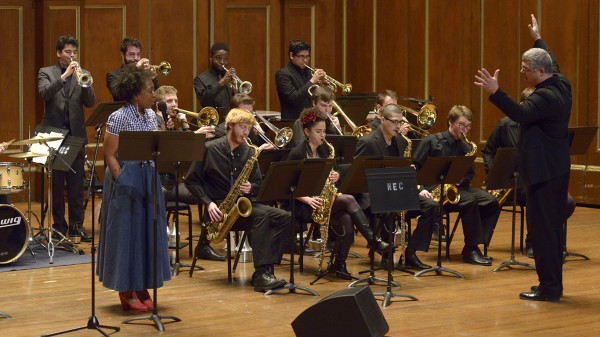
Recreating Sammy Nestico’s arrangements for Sarah Vaughan and the Basie orchestra. Photo: Andrew Hurlbut.
All of this is by way of saying that the Conservatory was very bold to try to do this material live, and that Nedelka Prescod, who had the task of competing with the band and living up to Sarah Vaughan’s standard, is a very courageous woman. Most of the time, it was possible to hear her and to determine that she has a good instrument and excellent control. Her upper register is not as strong as her mid-range, and especially in those big brassy closing ensembles, she was swallowed up altogether. What I could hear of her work was gorgeous, and I would very much like to hear what she can do in a more intimate setting. The only flaw I noticed was a little insecurity doing the octave leaps in “Ill Wind,” but this is a very minor criticism.
As for the instrumental execution, it was a revelation to hear the Nestico arrangements in a real hall, unprocessed and in three dimensions. Ken Schaphorst brought all the power I expected out of the NEC Jazz Orchestra, but there was a surprising amount of delicacy and detail as well.
Pops Goes the Jazz
The concert opener provided a bookend to Schuller’s Brubeck tribute, in a concerto for bass trombone and orchestra by Dave Brubeck’s son Chris, who wrote it for his own performance.
The piece has since been embraced by trombone players, and it’s made many appearances on Pops programs. No wonder. It is that great rarity—a genuinely balanced piece of music, smart enough to be esthetically satisfying and fun enough to delight the groundlings. The slow movement (“Sorrow Floats”) is lyrical and tuneful, and the third (“James Brown in the Twilight Zone”) gives orchestral percussionists the rare chance to get funky. It moves effectively from classical wind band timbres to big-band jazz to Broadway pit ensemble without sacrificing substance. In the third movement particularly, the interplay among the sections and the use of space is top-notch.
The spotlight is on the soloist from almost the first note, and Technical Sergeant Matthew C. Erickson rose to each of Brubeck’s challenges. He has a creamy, rich sound that suited the slow movement well, and in the two cadenzas of the last movement, he showed off impressive control of every register of the big horn.
Erickson’s personal presence added another dimension. He performed in full uniform, and his regulation posture made his six and a half feet seem even bigger. I considered his career as I heard him play: here is a virtuoso player who is also a career military non-commission officer. With the support of the Air Force, he has a dual career, guiding ensembles like the USAF Concert Bands and Brass in Blue and performing as guest soloist with professional orchestras as well. He’s overseen twelve world premieres or commissions and led ensembles in Iraq and Afghanistan. That’s a big man with a lot of brass, no matter how you define it.
Enter (and Exit) Zappa
Throughout his career leading the Mothers of Invention and performing as a solo artist, Frank Zappa maintained that he was primarily a composer. He was fond of quoting Edgard Varese (“The present-day composer refuses to die!”) even though most of his audience had no idea what Zappa meant or who Varese was. In performance, he often took relatively short pieces of music like “The Orange County Lumber Truck” and expanded them into long meandering jams that almost qualified as jazz, depending on the skill level of the soloists in his band at the time. He also wrote some of the most insulting and/or Dadaist song lyrics ever to be heard in a rock and roll context. Shot through it all was a constant of (sometimes overly) broad humor.
The March 6 concert concluded with “The Dog Breath Variations,” Zappa’s concert-band expansion of a theme that first appeared on his two-LP set Uncle Meat (Bizarre/Reprise, 1968). It was not exactly on the same intellectual level as the music by Schuller and Babbitt, but it provided a bracing outro nonetheless.
Most of Zappa’s formal compositions, tucked away in odd corners of his recordings, show off a heavily staccato style with accents and emphasis from marimba, xylophone, glockenspiel and other percussion. He produced many of the effects with synthesizer or audio processing, and the overall impact is almost like that of electronic music bent to the will of a rocker—complemented (or if you will, hampered) by a tight, dry acoustic that rarely let the music breathe in open space. Hearing the same notes played by a large concert ensemble (some 20-plus winds, plus two electric keyboards, electric guitar, two contrabasses, electric bass and a percussion arsenal that included traps, parade drum, a large gong, and the indispensable mallet instruments) in Jordan Hall gave the piece more grace and depth than I expected, and even a vaguely Russian quality that recalled Prokofiev or Shostakovich in their more mechanical moments. At other moments, it was like a collaboration of Raymond Scott and Sun Ra. Nonetheless, for me, the pretensions still outweighed the substance, the pieces didn’t add up to a whole…and there wasn’t much to laugh at, either.
Coda
The entire concert is now available for on-demand listening via InstantEncore, through the NEC website. The sound quality of these NEC-engineered recordings is outstanding, and if any of the above descriptions piques your curiosity, I strongly recommend a listen or two. You will have to register with your email address, but it’s worth it.
Steve Elman’s forty-three years in New England public radio have included ten years as a jazz host in the 1970s, five years as a classical host in the 1980s, a short stint as senior producer of an arts magazine, thirteen years as assistant general manager of WBUR, and currently, on-call status as fill-in classical host on WCRB / Classical New England three years. He was jazz and popular music editor of the Schwann Record and Tape Guides from 1973 to 1978 and wrote free-lance music and travel pieces for The Boston Globe and The Boston Phoenix from 1988 through 1991.
He is the co-author of Burning Up the Air (Commonwealth Editions, 2008), which chronicles the first fifty years of talk radio through the life of talk-show pioneer Jerry Williams. He is a former member of the board of directors of the Massachusetts Broadcasters Hall of Fame.
Tagged: Charles Mingus, Charles Peltz, Chris Brubeck, Dave Brubeck, Frank-Zappa, Gunther Schuller, Ken Schaphorst, Milton Babbitt, New England Conservatory

